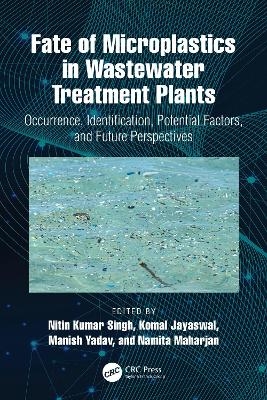
Fate of Microplastics in Wastewater Treatment Plants
CRC Press (Verlag)
978-1-032-53877-8 (ISBN)
- Lieferbar (Termin unbekannt)
- Versandkostenfrei innerhalb Deutschlands
- Auch auf Rechnung
- Verfügbarkeit in der Filiale vor Ort prüfen
- Artikel merken
This book covers the various sources, the role of treatment technologies, system-associated factors, and future challenges with reference to microplastics in wastewater treatment plants. It also introduces microplastics, their sources, governing factors, microbial diversity effects, and possible control approaches to minimize the exposure of microplastics to human beings. Modelling and distribution of microplastics, environmental sinks, bioindicators, and microplastics as vector in wastewater treatment units are also discussed.
Focuses on microplastic pollution, mechanism of removal, treatment technologies, pathways, and fate in wastewater treatment system
Discusses the factors linked to dispersion, survival, and removal efficiency of microplastics in wastewater treatment systems
Helps understand ‘microplastics removal’-centric sustainability aspects of wastewater treatment systems
Explores the fate of microplastics in sludge-handling systems
Incorporates comparative case studies from developed and developing nations
This book is aimed at graduate students and researchers in environmental science and engineering, water resources management, wastewater, and chemical engineering.
Nitin Kumar Singh is an Associate Professor in the Department of Chemical Engineering at Marwadi University, Gujarat, India. He earned his PhD from Indian Institute of Technology Roorkee in Environmental Engineering, M. Tech. from Indian Institute of Technology Kharagpur in Environmental Engineering, and B. Tech from Institute of Engineering and Technology Lucknow in Chemical Engineering. He has more than 12 years of experience in the field of wastewater treatment, waste management, green synthesis and processes, cost-benefit analysis, biological air pollution monitoring, and sustainability assessment of environmental systems. As of now, he has published over 39 SCI articles, 16 book chapters, 12 papers in international conferences, and edited 2 international books with international publisher. Manish Yadav is a Manager in Central Mine Planning Design Institute Limited, a subsidiary of Coal India Limited, India. He did his master’s in environmental engineering and B. Tech. in Biotechnology. He has more than 10-year experience in mining industry, especially in environment division. He is NABET approved expert in Air Pollution (source apportionment study, air quality modelling, air quality assessment) and Water Pollution (Wastewater treatment, adsorption, ground water quality assessment). His core area of expertise is Environmental Impact Assessment. He has published more than 17 papers in reputed international journals along with 12 book chapters in reference books. He has also prepared many consultancies report on environmental problems. He is appreciably skilled in various data analysis and modelling software including AERMOD, Aquachem, Openair, R software, SPSS, Origin, ArcGIS, ArcSWAT and ERDAS etc. Komal Jayaswal is an Assistant Professor in the Department of Civil Engineering at GITAM University, Hyderabad. She completed her Ph.D. in Environmental Engineering from IIT Roorkee. She did her Master’s degree in Environmental engineering from NIT Allahabad and Bachelor’s degree in Biotechnology from SHIATS Allahabad. Her area of research includes energy efficient and nature-based technology for wastewater and water treatment systems, anaerobic wastewater treatment system and sludge characterization and solid waste management. She has 10 years of experience in the domain of environment waste management and wastewater treatment and has worked for both field scale and lab scale wastewater treatment technology. She has published 5 research articles, three book chapters and presented her work at international conferences. Namita Maharjan is an Assistant Professor in the department of General Education at National Institute of Technology, Nagaoka, Niigata, Japan. She did her PhD and M. Tech from National Institute of Technology, Nagaoka, Japan in Environmental engineering. Her area of research includes assessment of wastewater treatment systems, microbiology of wastewater treatment plants and aerobic post treatment system. She has more than 10 years of experience in the field of wastewater treatment system with expertise at laboratory and field scale. She has published more than 15 research articles, book chapters and presented her work at several international conferences.
1. Examining the Presence of Microplastics in Wastewater: A Bibliometric Analysis and Overview. 2. Characterization Techniques for Quantifying Environmental Microplastics. 3. Plastic Peril: Unraveling Microplastics Threats to Health and Ecosystems. 4. Bioindicators of Microplastics. 5. Role Of Various Microbes and Their Enzymatic Mechanisms for Biodegradation of Microplastics. 6. Microplastics in Aquaculture: Implication on Fish and Human Health. 7. Investigating Approaches and Technologies for Microplastics in Wastewater Management. 8. Characterization and Removal of Microplastics in Different Stages of Wastewater Treatment Plants. 9. Environmental Sink of Microplastics Associated with Wastewater Treatment and Allied Processes. 10. Mass Balances and Life Cycle of Microplastics Across Wastewater Treatment Plant: A Process Review. 11. Wastewater Treatment Plants as a Key Source of Secondary Microplastic in the Urban Environment: A Case Study from Uttarakhand, India. 12. Distribution of Microplastic in Egypt Wastewater Using Aquatic Insects as Bioindicators. 13. Recent Trends in Microplastic Detection based on Machine Learning and Artificial Intelligence. 14. Artificial Intelligence and Machine Learning Approaches for Automatic Microplastics Identification and Characterization.
| Erscheinungsdatum | 18.10.2024 |
|---|---|
| Zusatzinfo | 23 Tables, black and white; 13 Line drawings, black and white; 14 Halftones, black and white; 27 Illustrations, black and white |
| Verlagsort | London |
| Sprache | englisch |
| Maße | 156 x 234 mm |
| Themenwelt | Naturwissenschaften ► Chemie ► Technische Chemie |
| Technik ► Bauwesen | |
| Technik ► Elektrotechnik / Energietechnik | |
| Technik ► Maschinenbau | |
| Technik ► Umwelttechnik / Biotechnologie | |
| ISBN-10 | 1-032-53877-5 / 1032538775 |
| ISBN-13 | 978-1-032-53877-8 / 9781032538778 |
| Zustand | Neuware |
| Haben Sie eine Frage zum Produkt? |
aus dem Bereich


